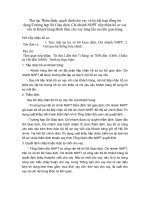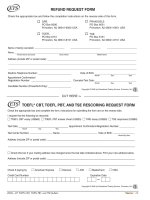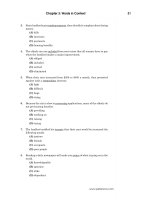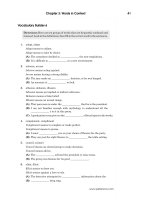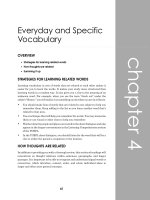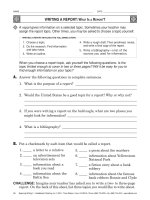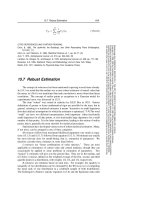Tài liệu Pharmaceutical Coating Technology (Part 8) pptx
Bạn đang xem bản rút gọn của tài liệu. Xem và tải ngay bản đầy đủ của tài liệu tại đây (2.61 MB, 35 trang )
Page 205
8
Coating pans and coating columns
Graham C.Cole
SUMMARY
This chapter provides some examples of the type of equipment that is currently available. It is not
exhaustive, but will highlight the main features that should be considered when evaluating and selecting
appropriate units together with ancillary equipment for spraying and control of the coating process.
8.1 CONVENTIONAL COATING PANS
It is not proposed to discuss in detail the use of conventional coating pans as these are being phased out
with the preference for more sophisticated pans and systems.
Various methods have been used to improve the coating characteristics in this type of pan which was
originally designed for sugar coating. Some examples are shown in Figs. 8.1
– 8.3.
The modifications made to sugar-coating pans were an attempt to utilize existing equipment and
while successful for solvent-based film-coating systems, they do not have the advantages of side-vented
pans when aqueous film coats are applied.
8.2 MANESTY ACCELACOTA
The Accelacota is used as a model against which all other manufacturers’ units are compared. That is
not intended to imply any preference, but as a means of providing a road map through the maze of
information available.
The data quoted is intended as a guideline to indicate the range and size of the Accelacotas and the
most suitable ancillary equipment available. Margins of safety
Page 206
Fig. 8.1 Standard coating pan.
have been included to allow for a range of operating conditions. They should not be considered as
specific nor should they be compared with other manufacturers’ quoted data. Where comparisons are to
be made, these should be related to the particular coating conditions. Like must be compared with like.
Four sizes of Accelacota are available:
The essential features are illustrated in Figure 8.4
.
The Accelacota has a horizontal rotating cylindrical drum, the curved surface of which is uniformly
perforated. The ends of the cylinder are conically dished, so that tablets in the drum are inverted and
also mixed laterally during the coating operation. There are baffles to assist the mixing process. Drying
air enters the drum through the perforations on the side remote from the tablet bed, and is drawn through
the bed by the exhaust fan located in the exhaust duct connected to the plenum positioned under the
tablet bed. This plenum has a mouth that fits closely to the outside of the perforated curved surface of
the drum.
The angles of the front and rear sides of the pan are 56° and 61° respectively, which was originally
intended to ensure complete mixing of the tablets from the top of the bed to the bottom and from front to
rear. However, it was found that this was insufficient to ensure homogeneous mixing and baffles were
fitted. Generally,
•
Model 10, operates with a batch size of 8
–
18 kg.
•
Model 75, operates with a batch size of 40
–
90 kg.
•
Model 350, operates with a batch size of 250
–
450 kg.
•
Model 150, operates with a batch size of 80
–
180 kg.
Page 207
Fig 8.2 Standard coating pan and a Pelligrini pan using the Glatt immersion
-
Sword system.
Page 208
Fig. 8.3 Standard coating pan using the immersion tube system.
Fig. 8.4 Manesty Accelacota.
Page 209
the baffles are of the same shape but of different size for each model and can be easily removed or
replaced with those of a different design depending on the physical characteristics of the tablet to be
coated, e.g. friability.
The batch size for each particular model will depend upon the bulk density of the tablets. Maximum
loading will be achieved with tablets made from a high-
density material or from small tablets which will
have a high packing density. Exceeding these maximum loadings can cause damage to the drive
mechanism.
Minimum loadings are found by experience and depend on size and shape of the tablets. If the units
are used with batch sizes below these levels, then it is likely that problems will be encountered due to a
large portion of the baffles being exposed above the tablet bed. In addition, the exhaust plenum will not
be completely covered and this can result in the drying air bypassing the tablets before entering the
exhaust duct.
Shape can affect the coating process in a number of ways. Tablets shaped as squares can cause
sticking problems and the formation of ‘twins’. Logos across the centre of bi-convex tablets result in
damage to the intagliations. It is, therefore, an aspect of tablet design which should be appreciated by
both marketing and formulation departments. Small tablets produce a very dense bed in the coating pan
which tends to reduce the batch size and increase the coating time.
For sugar coating it should be remembered that the maximum loads refer to the weight of the coated
tablets and not to the weight of the cores. Therefore, when pan loadings are optimized both the weight
of the core and coated tablet need to be taken into consideration.
Having decided upon a batch size, coating times can be estimated from the following:
1. Sugar coating. Approximately 6–7 h are required to double the core weight. Thicker or thinner
coatings will take proportionally longer or shorter. Coating time is directly proportional to the
weight of coating applied. This time is typical but very much shorter times can be obtained with
certain coating formulations and favourable tablet shapes. Care must be exercised when
comparing these times with those quoted by different equipment manufacturers as they may be
quoting times for favourable rather than average conditions. Considerably longer may be needed
to finish the coating to produce an elegant product with a high gloss.
2. Solvent-based film coating. From 30 to 90 min: 30 min is usual where a very thin transparent
coating is applied (this type of coating would be used to prevent dusting rather than as a
protective coat) but normal thicknesses require 45–60 mins. When coating a batch of small
tablets (less than 10 mm diameter) which has a high-density bed, the time could increase to
about 75 min. The longest coating time would occur when thick coatings are being applied to
small tablets.
3.
Aqueous
-based film coating. Coating times range from 45 min to 3 h with a typical time being
about 90 min. The lowest and highest times apply for a variety of reasons similar to those given
for a solvent
-
based coating.
Page 210
These times have been generalized and apply to all models. In practice, however, if a particular
coating formulation is used under similar conditions in a range of different sizes, the times tend to
increase slightly for the larger pans.
When evaluating the suitability of a particular model for a coating process, allowances must be made
for loading, unloading, cleaning and maintenance. For the Accelacota the following loading and
unloading options are available
The time required for each operation will depend upon the method used. The manual process can be
considered the worst case. The following times are typical:
The Accelascoop is available for the 75, 150 and 350 models and this attachment significantly
reduces the unloading time. Further improvements in productivity can be achieved by using a conveyor
rather than a container. Containers should be designed to hold multiples of the capacity of the
Accelascoop.
Mechanical or pneumatic loading and unloading systems can be designed to meet specific
requirements.
The Accelacota models 150 and 350 are available with automatic unload. This material handling
option allows for the automatic discharge of tablets, through an inward-opening flap in the pan, into a
product container or onto a conveyor.
Automatic unload may be operated manually or linked to a control panel as part of a fully automatic
coating system. This concept is illustrated in Fig. 8.5
.
8.2.1 Cleaning
Two options are available, the manual method and an automatic washing system called the Auto Wash
(Fig. 8.6
).
All Accelacotas are fitted with a sink below the coating drum which is used either as a unit to hold the
various cleansing agents or to collect washings from a clean-in-
place system. This is partially filled with
water, solvent or cleansing agent and the drum rotated through this solution. Where manual systems are
used, water (or solvent) can be sprayed onto the internal surface and collected in the sink and discharged
into an effluent system.
The clean in place (CIP) system (Auto Wash) can be fitted to both the 250 and 350 models. Designed
to operate inside the pan only, or in the pan interior, cabinet, and inlet and outlet ducts, strategically
positioned nozzles ensure thorough cleansing of the coating area and surrounding zone. Washing can be
linked to either a manual or a fully automatic control panel to form part of the complete coating
•
manual;
•
Accelascoop;
•
pneumatic transfer;
•
automatic unload.
Loading Unloading
Model 10 2–3 min 5 min
Model 75 4–5 min 8 min
Model 150 5–6 min 10 min
Model 350 10–20 min 30–40 min
Page 211
Fig. 8.5 Automatic loading and unloading system.
system. It should be remembered that the wash cycles need to be carefully formulated and validated.
The absence of active ingredients or excipients from the rinse water is not accepted by the FDA as
evidence that the equipment is clean. Swab tests will need to be taken from strategic points in the system
and analysed.
Coatings that are water soluble can be hosed off the inside of the pan and drained through the sink.
Alternatively, the sink can be filled and the pan rotated through it to dissolve material that has adhered
to the pan walls.
Cleaning after a sugar-coating process can be achieved in approximately 30 min in the best case, but
coatings that contain materials which cause strong adhesion to the pan will take longer. Allowing one
hour for cleaning would be quite generous, but it must be remembered that cleaning is an essential part
of cGMP (current Good Manufacturing Practice) and cannot be short-circuited.
8.2.2 The air flow system
A typical schematic layout is shown for free standing models in Fig. 8.7, which illustrates the coating
pan, hot air unit, fan unit (exhaust), damper controls and interconnecting duct work.
(a) Exhaust air
It is essential to have some means of drawing the air through the bed of tablets. In its simplest form this
consists of an exhaust fan and ducting to carry the air from the plenum to the fan and from the fan to the
atmosphere. The optimum quantity of air will vary with the evaporation rate required; the total pressure
drop will depend upon the resistance to air flow of the tablet bed, the resistance of the exhaust ducting,
and any additional equipment such as filters and solvent recovery system that may be fitted. It should be
remembered that the exhaust air will contain a
Page 212
Fig. 8.6 The Manesty Auto Wash system.
percentage of particulates ranging in size from submicron to 200–300 µm and levels of solvent.
Additionally conditions will not always be constant. The type of coating may change, the batch size may
vary and the inlet air conditions may also vary. An oversize fan is therefore used and a damper is
incorporated into the exhaust ducting to adjust the air flow for particular conditions. It is essential to
have a control and instrumentation system that will modify the condition of the air as it enters the
coating pan, depending on the local climatic conditions.
Sugar coating
For this process it is necessary to stop the air flow at various stages during coating.
Page 213
Fig. 8.7 Schematic of complete air flow system.
This can be achieved by closing the damper completely. Stopping the fan has been found to be an
unsatisfactory means of shutting off the air flow because natural convection takes place through the
ducting and this will affect the quality of the coating.
The Model 10 contains an exhaust fan and damper unit built into the cabinet which requires
connecting to an external exhaust duct and filter system. Models 75 and 150 incorporate a free-standing
exhaust unit which contains the fan, motor, starter and the damper valve. The damper valve can be
manually preset to a partially or fully open position to regulate the air flow and can be moved from the
preset position to the fully closed position by a pneumatic signal. The equipment is housed in a cabinet
with a sound-absorbing lining to reduce the noise of the fan. These units are suitable for standing
alongside the appropriate model or mounting remotely and using interconnecting ductwork. An
overrated fan is used which allows for longer lengths of ducting to be used when necessary. The
required volume of air can be regulated by means of a damper valve.
The Model 350 requires a much larger air volume and flow. The size of the fan and the unit housing
the fan and starter would be too large and expensive to be conveniently sited alongside the Accelacota.
It is essential to design a properly balanced system. The use of qualified heating, ventilating and air-
conditioning engineers to achieve this is the best option. The fan and starter and a section of
Page 214
ductwork containing the damper valve and assistance with the ducting layout can be obtained from
Manesty for integration into the facility.
To prevent atmospheric pollution a filter must be fitted in the exhaust ducting, and it may be
necessary to use a more powerful fan to overcome the resistance of the filter as its efficiency is reduced
during the coating process. This will affect the coating, resulting in a reduction of the rate of
evaporation, a reduction in the spray rate and longer coating times. It is, therefore, advisable to fit some
form of pressure drop indicator to the filter. A simple manometer with alarm can be sufficient to warn
the operator that conditions are changing and that the filter requires cleaning. Alternatively, a more
elaborate filter system with automatic cleaning could be employed. Alternatives to filters are discussed
in Chapter 9
.
(b) Inlet air
In the simplest case, and for the smallest pans, the drying air can be drawn into the pan from the coating
room. However, the suitability of the air will depend upon the type of coating process being carried out
and the temperature and relative humidity of the air. It is unlikely to be suitable unless the coating is an
organic solventbased film and the air is conditioned to about 30% to 35% r.h. at 20–22°C. Even if these
conditions are met the additional load which the coating process will place on the air-conditioning
system for the building should be evaluated before deciding to use localized environmental air.
Generally, an inlet air system is required. This normally consists of a filter to remove coarse particles
from the air which may be drawn from outside the building: a fan; a heat exchanger; a fine filter to
prevent product contamination and a damper to regulate the air flow. In theory the exhaust fan should
draw all its air from the inlet system. This would necessitate the coating pan being sealed, but if the door
is opened to examine the tablets the inlet system would be by-passed. It is, therefore, preferable to
install a fan with just sufficient power to overcome the resistance of the filters, heat exchanger and
ducting.
A hot air unit incorporating a fan, heat exchanger and filter, together with fan starter and the damper
valve for the 10, 75 and 150 models are suitable for standing alongside the appropriate model and can be
connected by a short length of ducting. Alternatively, they can be remotely sited. In the case of the
larger 350 model a separate fan, heat exchanger and filter are incorporated into the inlet air-ducting
system.
8.3 GLATT PERFORATED COATING PANS
Glatt manufacture a wider range of coating pans than Manesty. These start with the laboratory coater
with a capacity of 2.5 litres (1–2 kg) up to the GC 2000 with a capacity of 1250 litres (620–1000 kg). In
general terms the concepts are similar but Glatt have developed the interchangeable pan option much
further and they also provide more sophisticated automated washing systems.
The laboratory coater GC 300 provides an easy to clean option and a built-in data-processing system.
The pan can be easily removed for washing purposes.
Fig. 8.8
illustrates this operation.
Page 215
Fig. 8.8 Glatt Coater GC300.
Page 216
Fig. 8.9 Data acquisition system.
The process parameters monitored by its data acquisition system are illustrated in Fig. 8.9. This
concept has been further extended to some of the larger laboratory models shown in Fig. 8.10
. The
advantage of this type of system is that options for coating pellets and various sizes of tablets can be
incorporated onto one machine by having pans with different size perforations. The downside is the
need to have a clean storage area available and a means of changing the pan from one size to another.
However, advantages in cost, floor space, cGMP and the different process development options clearly
outweigh any disadvantages.
8.3.1 Loading and unloading
These operations are illustrated in Fig. 8.11. Manual loading, semi-automatic or automatic options are
available and are controlled as shown in Fig. 8.12
.
Several items of equipment are required. In the semi-automatic operation it is necessary to have a
lifting device to raise the product container to a height where it can be inverted into a funnel or similar
transfer chute to convey the tablets into the coating pan. In automatic systems the tablets are usually
transferred from an intermediate bulk container (IBC) which may be moved by an automated guided
vehicle (or fork lift truck) or conveyed pneumatically from a silo to the coating pan. The illustrations in
Fig. 8.11
shows a silo feeding tablets into the coating pan.
Page 217
Fig. 8.10 Laboratory coating Pan Interchange System.
Discharge
There are many variations of ways of unloading coating pans. Glatt uses a variation of the Accelascoop
device as one method. This requires fitting a specially designed scoop and reversing the coating pan
motor to discharge the tablets into a container. Alternatively a flap can be incorporated into the pan and
the tablets discharged into a mobile trolley or large funnel before being conveyed pneumatically to an
IBC or silo.
Cleaning
A schematic is shown in Fig. 8.13. The cleaning system consists of a spray nozzle integrated into the
coating spray arm for spraying the entire drum interior and a set of separate nozzles used to clean the
pan exterior. The cleaning liquid is collected in a tray below the coating pan. This permits the coating
pan and baffles to be immersed and rotated through the cleansing agent. After completion of the
cleaning process the solution is drained and the drum is rinsed. The cleaning of the spray
Page 218
Fig. 8.11 Automatic loading system.
nozzles and supply tubing is included in the cleaning process. Usually water pressure is sufficient for
cleaning; however, where high-pressure water is needed, a pump can be fitted.
Spray system
All spray systems need to be designed around the requirements of the coating solution to be sprayed and
the tablet substrate. A schematic of the Glatt system is shown in Fig. 8.14 and the actual arrangement in
Fig. 8.15
.
Page 219
Fig. 8.12 Automatic Control System for loading.
8.4 DRIAM
Driam claim that their unique system of controlling the drying air and reversing the flow at critical
stages of the coating process provide advantages particularly when coating friable tablets. The
interchangeable perforation sections enable a wide range of tablets, pellets and granules to be coated.
Driam claim that:
1. Products are handled more sympathetically as drying air is introduced from below into the pan,
giving rise to a fluid bed action. This separates the tablets and provides an envelope of air around
the product separating it both from other products and the pan walls.
Page 220
Fig. 8.13 Glatt cleaning system.
Driam manufacture a range of nonagonally shaped coating pans with capacities of between 5 kg and
600 kg. The laboratory model, DRC 500/600 Vario, is equipped with an interchangeable pan which
provides the flexibility of different operations:
2. The direction of the way the air is introduced can be reversed, the previous air inlet becoming
the air exhaust and vice versa. For example, when polishing is required after coating, the
polishing agent is introduced into the pan and the direction of the air is reversed. To achieve a
good polish it is necessary that the tablets rub against each other and the pan walls, and this
process is improved by low air pressure.
3. This method results in good mixing of the tablets which, combined with the close control of
spraying, gives a homogeneous coating.
4. The air requirements are substantially lower when compared with other manufacturers’ units. In
conventional pans the air often strikes the product and is exhausted without any drying effect.
This cannot happen in the Driacoater, and consequently, with lower air requirements, there is a
saving in energy costs.
Page 221
Fig. 8.14 Schematic of Glatt spray system.
In the Varico combination unit it is claimed that the load can be reduced to 2.0 kg for coating in a
similar way to the Driacoater 500 which was designed as a single unit for small batches of tablets of
between 2 and 6 kg.
The Driam differs from the Accelacota and Glatt coaters in the shape of the coating pan and the way
the air is utilized in the drying process. This is shown in Fig. 8.16
. On the outside of the drum covering
the perforated areas, there are the air flow channels with removable covers. At the rear of the pan the air
channels are connected to the air distributor. This distributor guides the drying air through the air
channels and the perforations into the product. The direction of air flow is reversible.
In contrast to the production machines, the laboratory unit is a complete and self-contained piece of
equipment with built-in air supply and exhaust, steam heating, spray system, a completely contained
cleaning system with pump, and all control and monitoring instruments. The unit is mobile, requiring
little space, and is operational after connections have been made to electric power, steam and
compressed air supply. The air volume and the differential pressure in the drum are adjusted by the air
control dampers in the air supply and exhaust system. A built-in temperature control stabilizes the pre-
set air supply temperature. The casing, the drum and all parts in contact with the product are of 304
stainless steel. A special stand is
•
a range of capacities of 5 to 30 kg;
•
a range of perforation inserts from 0.2 to 3.0 mm.
•
Direct Air Flow:
Air is supplied through the perforated areas at the top of the pan and through the
product bed, and the air exhausted through the perforated areas under the product.
•
Reverse Air Flow:
Air is supplied through the perforated areas at the bottom of the pan and
through the product bed. It is exhausted through the perforated areas at the top of the pan or
through the hollow shaft at the rear.
Page 222
Fig. 8.15 Glatt Spray System, actual.
available to change the coating pans in the 500/600 Vario model. The control cabinet is fitted with
gauges to monitor:
Controls and switches are available for:
•
temperature of the air supply;
•
temperature of the exhaust air;
•
the differential pressure in the coating pan;
•
the air volume in cubic metres per minute (m
3
/min).
•
drive;
•
spraying;
•
air supply;
•
air exhaust;
•
heater;
•
cleaning pump;
•
atomizing air;
•
temperature control;
•
emergency stop;
•
compressed air;
•
time control (generally an option for sugar coating only).
Page 223
Fig. 8.16 Driam coating pan.
The Driacoater 500/600 Vario comes with various options.
Type Batch Capacity
500/016 5kg
600/016 10kg
500/031 10kg
600/031 20kg
600/046 30kg
Drum diameter 500–600 mm
Speed range 5–27 rev/min
Perforated inserts 0.2–3.0 mm
Page 224
The following production models are available:
The suffix 1 and 1.25 relates to the depth of the drum in metres.
A model 1200 with associated control cabinet and coating reservoir is shown in Fig. 8.17
.
8.4.1 Cleaning
As with all coating pans, attention to cGMP requirements is an essential part of an evaluation
programme to assess the suitability of the equipment for pharmaceutical production. The cleaning of
these pans is shown schematically in Fig. 8.18
. The process operates in four phases:
As in all cGMP operations, a check by Quality Assurance is an essential requirement. For inspection
the side panels can be opened to offer access to all parts of the equipment. The air channels can be
removed manually for swab and visual inspection.
8.4.2 Loading and unloading
On early Driacoater production models, loading of tablets was manually through the front of the unit. To
unload, a chute was fitted to the front of the pan, the rotation of the pan reversed and the tablets
discharged into an appropriate container. Options are available for rear loading, depending on the
particular requirements.
8.5 SIMILAR COATING PANS
Other side-vented coating pans, which are very similar to the Glatt Coater and the Accelacota, are
manufactured by Dumoulin in France and by Freund in Japan who manufacture the Hi-Coater. The Hi-
Coater was originally designed to overcome the patents on the Accelacota held by Eli Lilly, the
inventors. It has four perforated panels linked to air ducts that are in constant contact with the exhaust
ducts. It is illustrated in Fig. 8.19
.
Capacities range from 500 g load up to the HCF 200, claimed to hold 700 kg. Loading and unloading
can be achieved through the front of the unit and by a flap in the pan which discharges into a mobile
container under the machine or onto a conveyor.
8.6 PELLEGRINI COATING PANS
These pans are marketed by GS Technology of Bologna, Italy, who supply the
Model No. 900 1200 1600/600/1 1600/1.25
Drum diameter (mm) 900 1200 1600/600 1600
Batch sizes 60 120 300 500 600
1.
cleansing of the inside of the pan;
2.
cleansing of the outside perimeter;
3.
cleansing of the air channels;
4.
cleansing of the sink.
Page 225
Fig. 8.17 Driam 1200 model coating pan.
expertise in air handling spray systems, controls and coating technology. Pelligrini are the fabricators of
the pan.
These are non-perforated pans with capacities from 10 to 1000 litres. Originally developed for sugar
coating, they use baffles which give a very even distribution of the drying air through the tablet bed or
pellets. An advantage of this type of pan is that it can be used for coating a large range of particulate
sizes from less than a
Page 226
Fig. 8.18 Driam auto cleaning system.
millimetre to tablets of all shapes and sizes. It is claimed to be the best statistical mixer for coating
available.
The GS control and coating systems can be fitted to any coating pan, be it Accelacota, Glatt, Driam,
Hi-Coater, etc. This control, it is claimed, results in dramatic decreases in coating times, particularly for
sugar.
For film coating, GS have a special reciprocating piston pump, the speed of which is automatically
controlled from the bed temperature. For sugar coating, a modified GRACO pump is used.
The type of spray-gun, nozzle configuration and position above the bed is critical in all coating
processes. These are all either fully interchangeable or adjustable in the GS system.
Drying is effected through perforated baffles immersed in the bed of cores, similar to the immersion-
Sword technique, giving a very even distribution of drying of air and allowing a very low differential
pressure to be employed which reduces attrition considerably.
Two computerized systems are available which can be fitted to existing equipment: COMREC
monitors and records all process parameters; COMAUT monitors, records and controls the entire
process. A full printout, graphical representation and statistical analysis is obtained either through
COMREC or COMAUT.
A typical system is shown schematically in
Fig. 8.20
.
Page 227
Fig. 8.19 Freund Hi-Coater.
8.7 THE BUTTERFLY COATING PAN
These pans have capacities ranging from 15 litres up to 1200 litres and are manufactured in Germany by
Huttlin. Originally developed for sugar coating, they are claimed to be suitable for all current types of
film coatings, and in particular for larger tablets.
The Butterfly pan (Fig. 8.21
) has a special pan cross-section with inward-sloping sides. The cross-
section of the pan containing the product area is shaped like a trapezium. In contrast to all other sugar-
coating pans this pan has its largest breadth at the biggest cross-section and its smallest breadth at the
smallest crosssection. Therefore, even with maximum load the height through which the product falls is
relatively small.
Intensive product movement is achieved which provides optimal mixing. In the interior of the pan
there are no blades or other baffles to mechanically stress the product.
Spray coating is effected at the point where the product is moving at constant speed in the narrow
section of the pan.
The loading and evacuation of the tablets (or pellets) is performed tangentially from the sides of the
pan through segments in the wall. This is a unique system which provides a very efficient handling
process.
Page 228
Fig. 8.20 GS control system.
Page 229
Fig. 8.21 The Butterfly Coater.
The side walls of the pan (which can be removed for cleaning) are attached by means of a simple
fastener enabling the pan walls to be dismantled and the coating pan thoroughly cleaned. As with the
other types of coating pans, automatic control systems are available to monitor and optimize the process
parameters.
8.8 COLUMNS: FLUIDIZED BED
As was mentioned in Chapter 1, fluidized bed coating columns were used in the early days by Abbott
Laboratories based on the Wurster process and latterly by Merck to coat tablets using air sprays and
solvent
-
based formulations. The Merck
